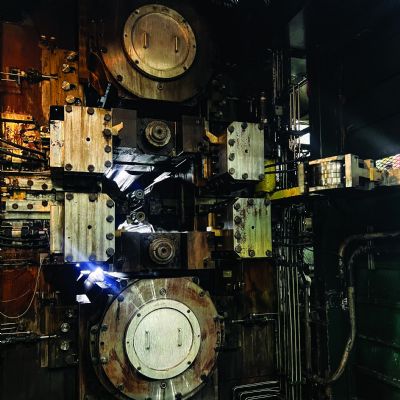Analysis—Many of these dwell procedures are possible. However, holding the sheetmetal at BDC will not cause a release or reduction of any elastic stresses.
• To determine material formability or stretchability, we use the limiting-dome-height test. Sheetmetal is accepted if the value exceeds 0.xyz.
Analysis—The LDH test uses a hemispherical-shaped punch to stretch strips of material in different widths, locked at their long ends. The tests are similar to those used to determine the forming-limit curve (FLC). The height of the test strip, which has no width change, is measured and used as the value for that batch of material. The value must exceed 0.xyz to pass the stretchability test. Unfortunately, the 0.xyz value can be reached by a poor-quality material with an excellent surface lubricant, an excellent-quality material with a poor lubricant, or every combination in between. There is no proof that the test result is completely due to the sheetmetal. While this test has lost favor, some groups still use it.
• The workpiece material exhibits inconsistent material properties—a good part has a hardness value of RB 42, and a bad part has a hardness of RB 44. We will reject any material with hardness greater RB 43.
Analysis—This situation violates several problem-solving rules. First, two samples do not represent a statistically valid test. What if another pair of samples showed the good part had an RB of 44 and the bad part RB 42? Will you reject all material with RB less than 43? Second, the two hardness readings are too close together to provide a separation of good and bad material. And third, formability depends on several properties, and hardness is not one of them. The hardness test goes back to the very early days when it was the only test available.
• We find the FLC does not work for blanked edges—it gives completely incorrect answers.
Analysis—The FLC provides the correct answers for the properties provided to make the calculations. The FLC depends almost entirely on the workhardening exponent—n-value. To predict allowable stretchability of a batch of steel, use the n-value obtained from the steel supplier or from a separate test. However, when blanking sheetmetal, the process workhardens the material and reduces the n-value. One set of tests may show that the workhardening went back one-half sheetmetal thickness from the cut edge, which has a stretching limit of 80 percent. The same batch of steel with a milled (non-worked) edge would stretch to 280 percent. Unless you obtain the n-value for the damaged edge, the FLC will give the correct answer—280 percent.
• We torch-anneal the steel on the blanked edge to restore stretchability.
Analysis—Annealed coils of steel have a constant amount of cold work throughout. Waving an extremely hot torch to a non-constant cold-worked edge can cause all sizes of grains to be generated in random patterns. Some extremely large grains can form that will easily initiate cracked edges and non-uniform deformation.
• The bad steel we ran today came from any of five heat numbers.
Analysis—Each 300-ton heat from an integrated mill can produce sixty 10,000-lb. coils, each processed differently. Good luck finding one unidentified coil among 300 possible coils (five heats). Therefore, stampers must keep the coil number with every coil, any mults from the coil and any blanks cut from the coil. Also, keep the coil number with every set of parts stamped from the coil, in case problems occur farther down the production line.
• I receive the “certs” that tell me all about the steel and its properties.
Analysis—The “certs” list includes carbon, manganese, phosphorus and sulfur for the entire heat. No mechanical properties are given.
• The n-value is commonly measured over the strain range of 10 to 20 percent.
Analysis—While once suitable for most steels, that strain range proves insufficient today—many of the higher-strength steels reach maximum load (ultimate tensile strength) at strains less than 20 percent. The onset of this diffuse neck will contaminate the n-value. Other steels have more uniform elongations that exceed 20 percent. Including the extended range of data creates a more valid n-value. The strain for n-value ranges from 10 percent to maximum load.
• I ordered coils of high-strength low-alloy (HSLA) steel with a yield strength of 350 MPa, and received some coils labeled HSLA 350 and others labeled HSLA 450. Is something wrong?
Analysis—No, the coils just came from different parts of the world. North American and European mills label HSLA steel by yield strength, while Asian and Pacific Rim suppliers use tensile strength. The coils labeled HSLA 450 came from Asian or Pacific Rim suppliers. To avoid this confusion, World-AutoSteel, the technical division of WorldSteel, has established a new classification. In this case, the coils would be labeled HSLA 350/450—identifying the yield and tensile strength of the steel. The metalformers can even obtain the TS/YS ratio and get a feel for its n-value. MF Industry-Related Terms: Blanking,
Case,
Center,
Die,
Edge,
Form,
Forming,
Strips,
Surface,
Tensile Strength,
ThicknessView Glossary of Metalforming Terms Technologies: Materials, Quality Control
 Stuart Keeler
Stuart Keeler






